Creating content as an agency is time-consuming and different. It takes a massive amount of time to generate new great content for each posting time for each social media platform for each client.
hbspt.forms.create({
region: “na1”,
portalId: “8477337”,
formId: “7b5bb39f-cd97-4a83-9934-a41acb1ccb5e”
});
But there are tricks and tips that agencies can use to ease the strain that comes with so much content generation for so many social media accounts.
For example, you can repurpose content to extend its lifespan and turn a single piece of content into several posts for example.
You can also cross-post as long as you follow best practices.
In this post, we’re going to discuss everything you need to know about what cross-posting is, whether cross-posting is bad, and best practices.
What Is Cross-Posting?
Cross-posting is the process of posting the same content across multiple social media profiles or channels.
It’s why you can view a brand’s Page on Facebook, see a post, then see a similar or identical one on the brand’s Twitter or Instagram.
You can copy and paste a post across multiple platforms to save time, but other solutions exist that make the process easier.
Agorapulse makes it easier to publish the same content across multiple platforms at once. You can select which platforms, profiles, and Pages you want a single post to be shared.
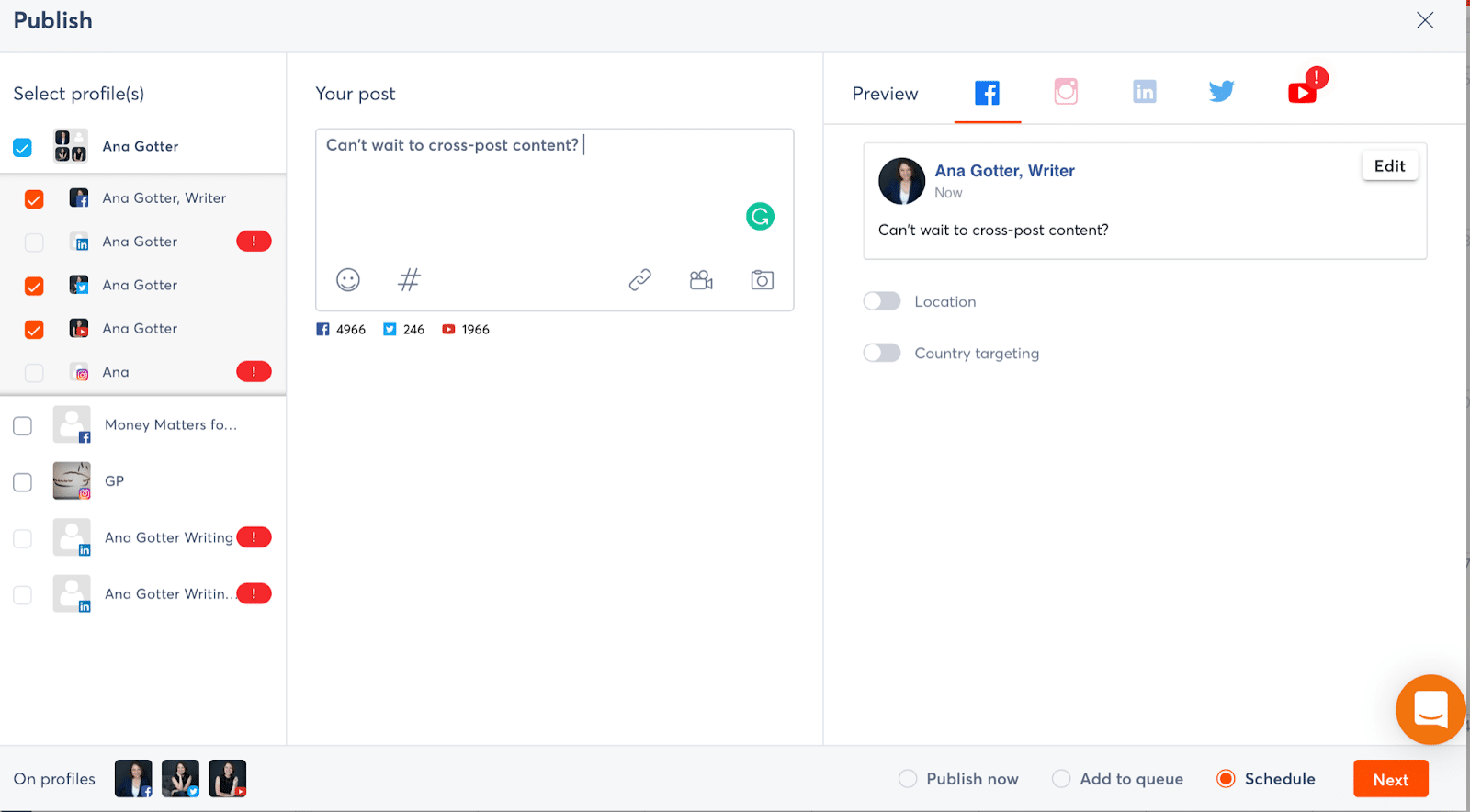
Why Does Cross-Posting Have a Bad Reputation?
Is cross-posting bad?
Cross-posting does not have the greatest reputation among social media marketing agencies or some of their clients.
That’s all because of what we consider to be lazy cross-posting. For example, some agencies might promise three posts a week for Twitter, Facebook, and Instagram each but intentionally fail to specify that those posts would be unique.
The agencies might just come up with three single post ideas a week and share them across each platform without modification.
In these cases, brands are not getting what they paid for. (They want great content, and they want it on more than one social network.)
Cross-posting that isn’t optimized for each individual platform can also perform poorly.
If you post on Instagram and include 15 hashtags, that’s not going to fit on your Facebook Page or your YouTube videos, or on LinkedIn.
The posts aren’t tweaked according to each platform’s best practices. So, it may fail across multiple networks, especially since users want different things on each platform (even if they follow you across each platform that you’re on).
Cross-posting, however, can be incredibly successful when implemented correctly.
Let’s take a look at a few key benefits associated with the practice.
What Are the Benefits of Posting the Same Content on Multiple Social Media Channels?
There are plenty of benefits to post the same content across multiple social media marketing channels.
You get more life out of a great idea
It is so shockingly difficult to come up with full and rich content calendars for every client. That is why repurposing content and cross-posting content are so valuable. 
You want to be able to share a great post more than just once on one profile. So, get the most out of it that you can, sharing the basic post (if slightly altered) across multiple different channels.
The post gets more reach
We know that social media marketing algorithms can be chaotic, especially for business accounts.
Facebook Pages have an average organic reach of 6.4% of the Page’s total audience. That is for relatively high-engaging Pages, too.
Maybe only one out of five of all of your Twitter followers see a single post. They don’t interact with your content much, so it doesn’t show up in their feed. Or only one in four of your followers on LinkedIn see a post because they don’t check the platform over the weekend, so your post got buried.
Maybe you had a user who missed the post on every platform so far. But they happen to see it on LinkedIn.
The reality is that organic reach and social media algorithms are complex. Some users are not seeing our content even once if they follow us across every platform we’re on.
Agencies can combat that by cross-posting, increasing the reach of a single post.
No audience segment gets missed
Have you noticed that some brands have much more active Instagram profiles compared to Facebook Pages? Some of your clients might even take this approach.
While there’s nothing wrong with it in theory, the reality is that maybe they have 500 followers on Facebook or LinkedIn that don’t also follow them on Instagram.
If Instagram is the only platform getting high-value content, plenty of social media followers are being left out.
Cross-posting allows you to share your best content to your entire audience, no matter where they’ve chosen to follow you.
Your profiles all have more content
Customers typically love to see brands that have social media profiles that are posting and engaging regularly. It shows that the business is active and invested in both its growth and customer relationships.
More content also means more chances to interact with your audience, generating conversations, and answering questions.
That is all good news.
Best Practices for Cross-Posting
Want to use cross-posting to delight your clients and their audiences instead of frustrating or boring them?
Take a look at these five cross-posting best practices every social media marketing agency needs to know.
1. Optimize the content for each channel
We’ve discussed above how one of the biggest social media cross-posting mistakes is to just literally copy and paste a single post across multiple channels and hit the publish button.
Definitely, definitely not.
You need to customize the content for each individual platform according to each platform’s best practices.
(We’ll show you how to do this easily in a few sections.)
Let’s take a quick look at some of the basic considerations when you optimize content for each channel that you cross-post to.
Visuals are not required but highly recommend as they increase performance.
Content with off-site links can see decreased organic reach, but you can still include those links and consider boosting the posts.
It’s best not to use hashtags except in groups to create searchable topics.
You can post over 5,000 characters in a post caption, but it’s best to keep it to around 40-90 characters.
You must use an image or video to post on Instagram.
You cannot add links to the posts themselves, only Stories.
Stories must be mobile-friendly and ideally with vertical images.
Around 11 hashtags are ideal.
You’ve got 2,200 characters per caption. but it’s best to keep it to around 125 characters.
Visuals are not required but highly recommend as they increase performance.
Long-form content often performs best, which can include multiple paragraphs.
You can have up to 120,000 characters on LinkedIn posts, though keeping it to four or five paragraphs max is best (and then, only when the topic warrants it).
Value-based content is best.
Using as professional of a voice as possible is ideal here since it’s considered a professional platform. (Emojis that you’d use on Twitter or Instagram may not fit here.)
Visuals are not required but highly recommend as they increase performance.
Stick to no more than two hashtags in most cases.
You have a strict character count of 280 characters, though you can create conversation threads.
Brevity and conciseness are valued; emojis are welcome.
hbspt.forms.create({
region: “na1”,
portalId: “8477337”,
formId: “7b5bb39f-cd97-4a83-9934-a41acb1ccb5e”
});
2. Stagger the publication dates and times
If there’s a non-urgent post that you want to share, consider staggering the posting dates and times. Doing so may increase the number of users who see the content. It also makes it so yours your highly engaged audience members don’t see it across multiple platforms.
Staggering the publication time of social content is easy to do.
Spread the post out across a month-long or week-long period, whatever is best for your team. Most users consume so much content that, even if they see it in multiple places, they likely may not even register that fact.
Not sure when to post on each platform?
You can use Agorapulse to see when your audience is most interactive with your content on each platform. You can use this to then determine peak posting times for each individual platform.
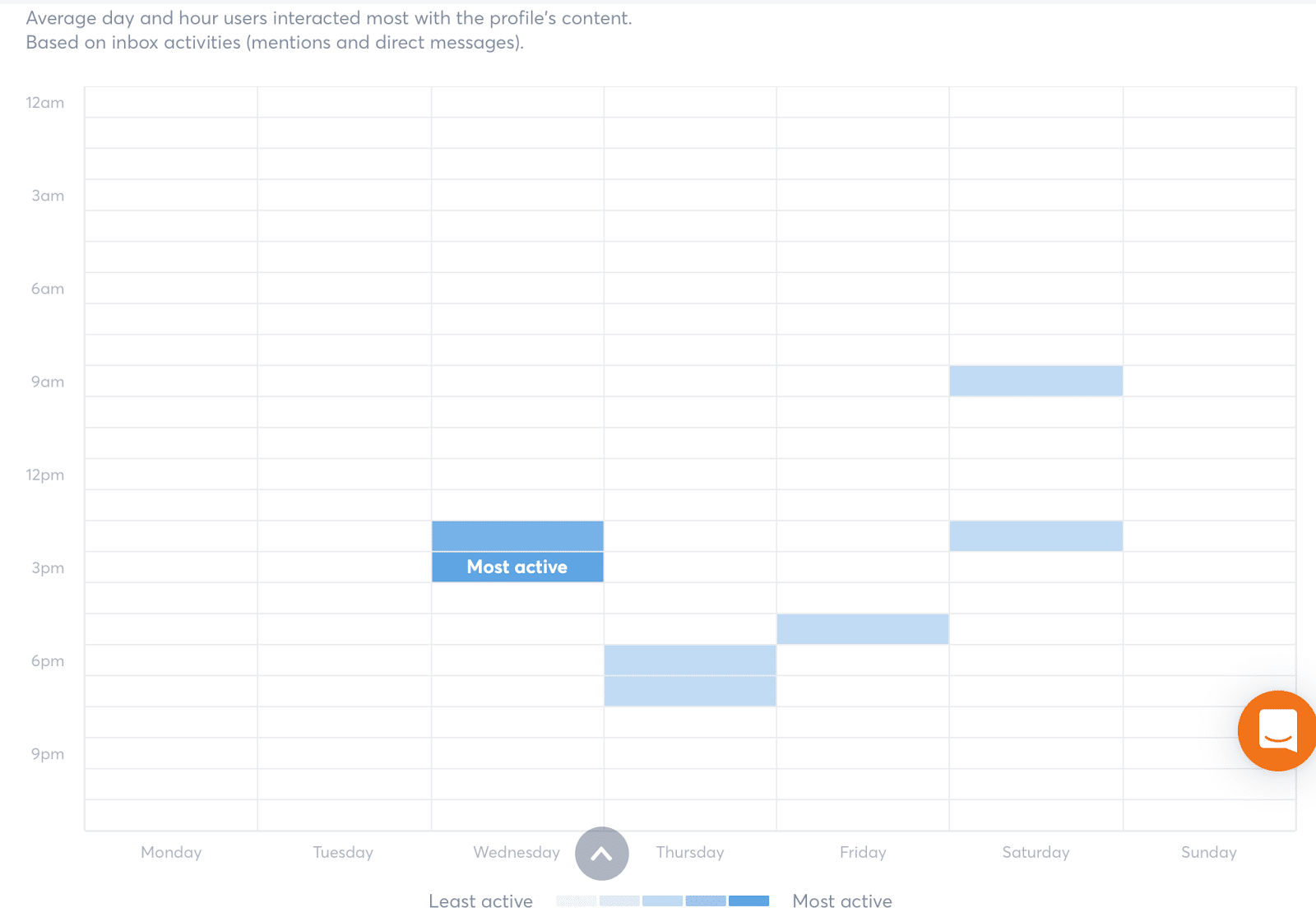
3. Tweak content to feel unique
In addition to optimizing content for each platform, you can also make adjustments to help each post feel unique, even if you’re getting at the same idea.
Here’s a great example, showing two posts from the same brand about the same blog post:


Even though they’re promoting the same content and this is effectively a cross-post, the brand uses different captions to entice different audiences into clicking.
Twitter uses a more statistics-heavy approach with hashtags, and Facebook keeps it simple to talk about what you can learn.
4. Understand your audience on each platform
Your audiences on every social media marketing platform are likely different, even if they all belong to your core audience overall.
LinkedIn, for example, typically skews male, and Instagram has a younger audience than some other platforms. You’ll want to adjust your content appropriately.
To help you determine who is currently following you on each platform, look at analytics data to assess who is following you where. Most platforms’ native analytics can show you information like the demographics, interests, language, and locations of your current audience. Use this to your advantage, customizing the cross-posted content for each audience as appropriate.
You can see what this looks like with Facebook’s Audience Insights here:
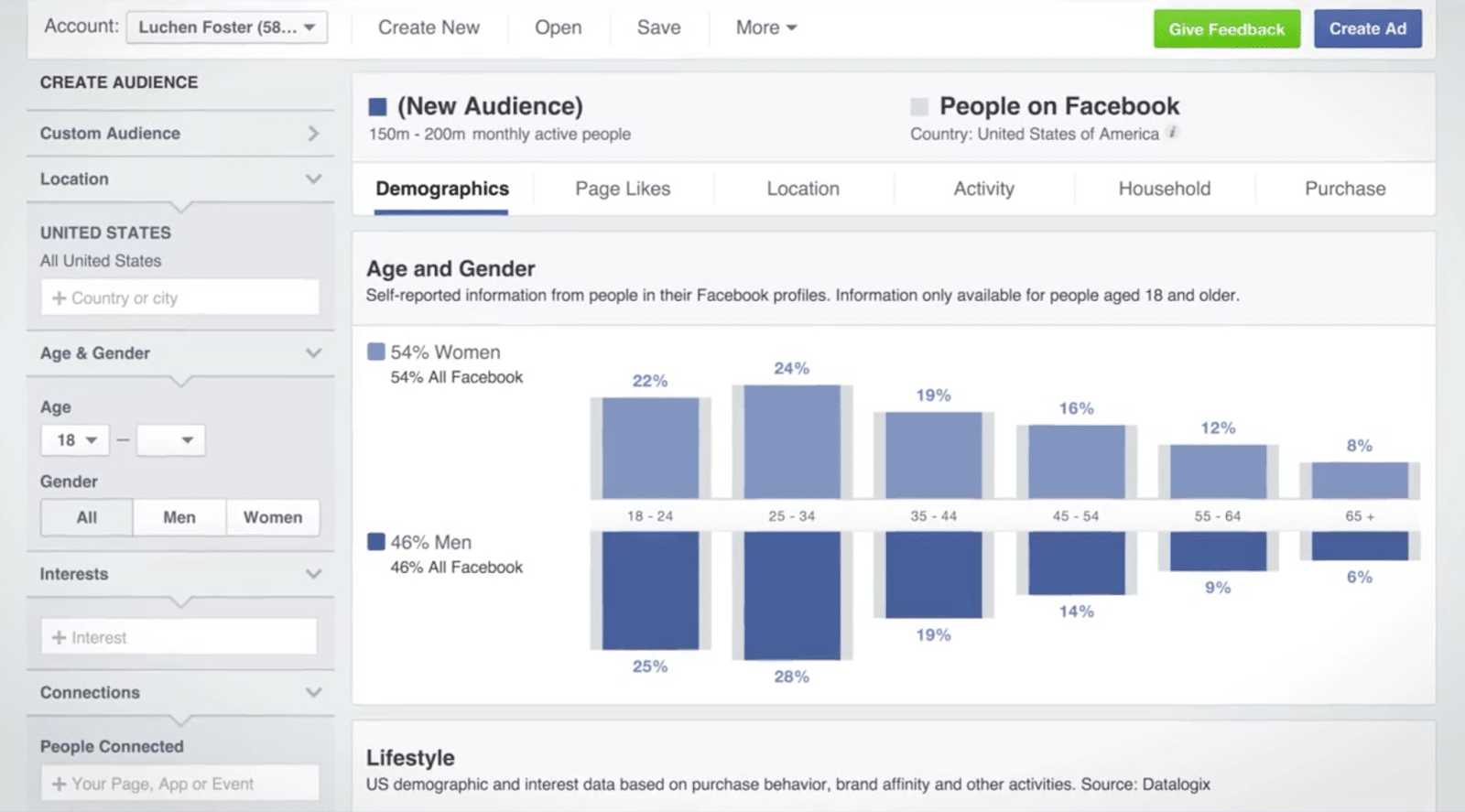
5. Use Agorapulse
We know that at this point in the post, you might be reading through everything and thinking, “Ugh, this is still a lot of work.”
We feel you.
Social media marketing is all about delivering the right content to the right people at the right time and in the right format. It’s heavily data-driven and strategic, and that does take a lot of time and effort.
We wanted to make it easier, though. That’s why social media management and scheduling tools like Agorapulse should be used for cross-posting.
You can schedule content to be cross-posted to different platforms all at once. Then (if you choose) easily drag and drop different posts to different dates for different platforms, all while seeing where the content falls and how it’s been adapted for each platform.
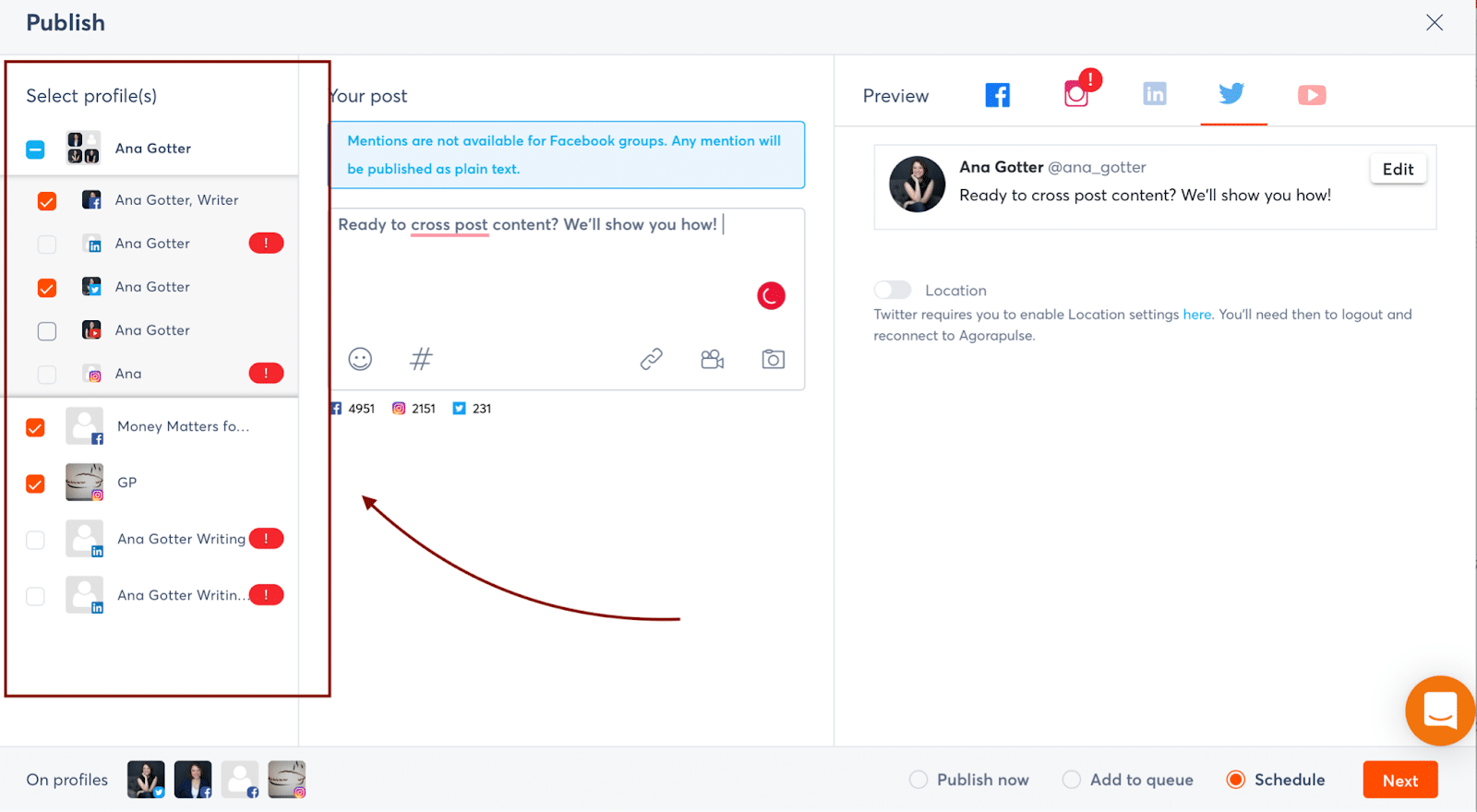
How to Customize Content for Each Channel
A large number of social media management tools on the market allow cross-posting, but not in a way that actually makes it easier for brands. We want to acknowledge this: Those tools just let you post a single, identical message across multiple platforms.
As we’ve already discussed in this post, that’s not the best way to go about it. At least not on a regular basis when you’re working as a professional social media agency that wants to keep its clients.
Agorapulse is different. We make cross-posting and cross-platform optimization both a simple, intuitive, and streamlined process.
First, we’ll keep you on track, showing you the specifications for each individual platform you want to post on. That includes character count limitations and reminders if needed media like visuals for Instagram and videos for YouTube.
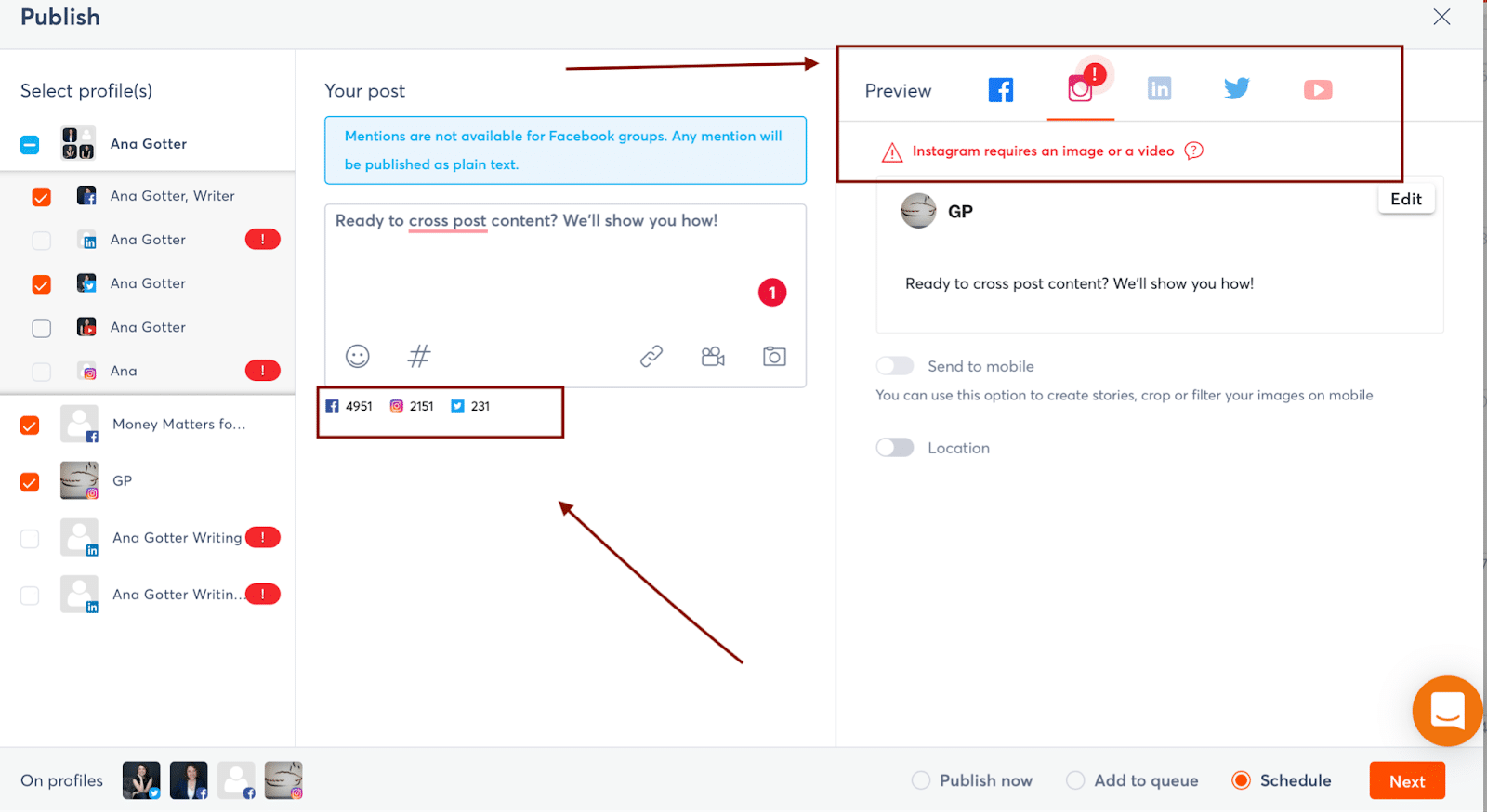
More than that, though, we make it easy to adjust the copy for each individual post.
To do this, click on the profile that you’ll want to change the text for in the preview section, then click “Edit” in the top right corner of the preview. Now, you can adjust the text just for the profile that you’re currently viewing, so you can optimize the content for each individual platform.
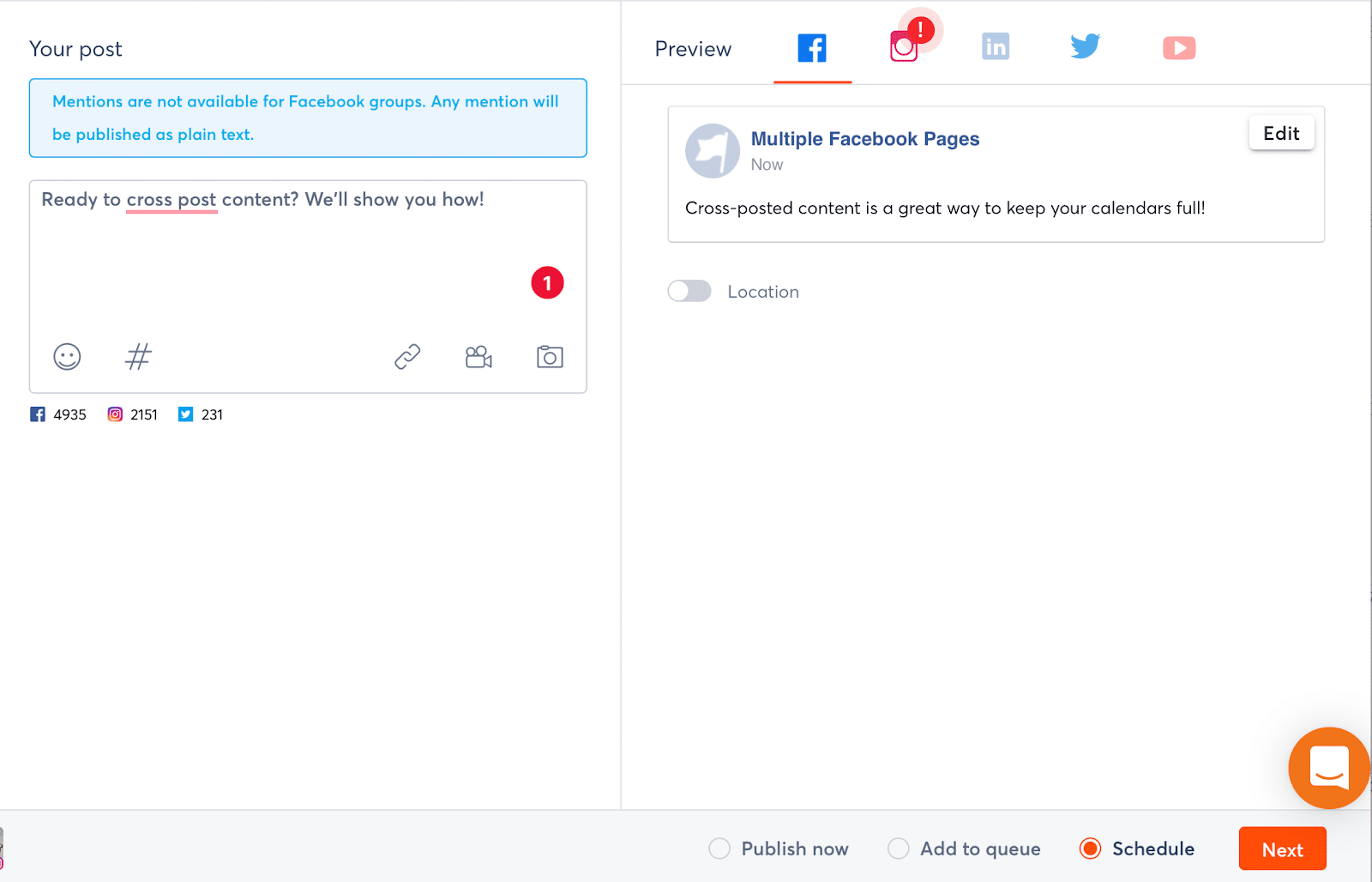
Then, once the content is scheduled, you can drag and drop the posts for each profile to different spots on the calendar if you want to shake it up.
You can also choose each post’s scheduling time uniquely or have them all published simultaneously, whatever is easiest for you.
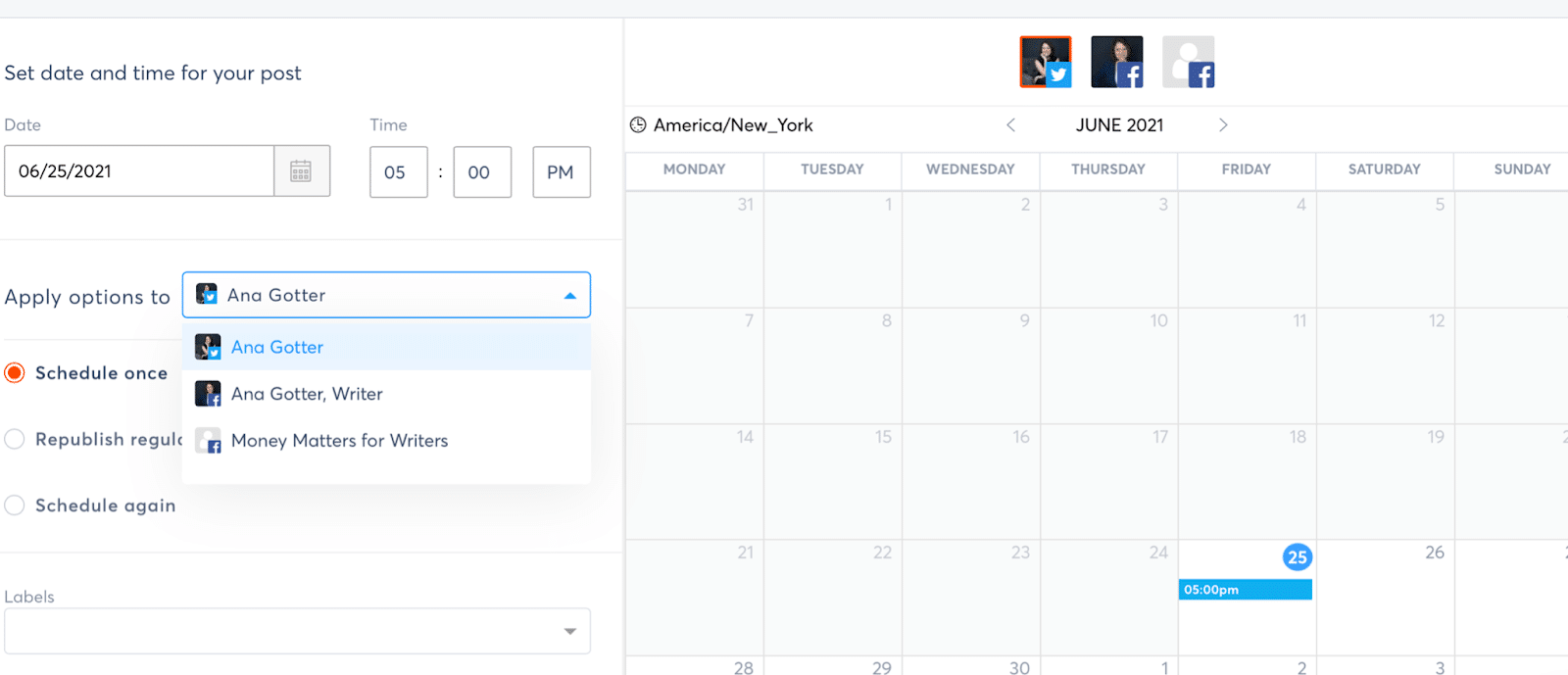
Agorapulse offers the option to cross-post across platforms and to customize the content for each social media profile. Thanks to this feature, social media managers save a lot of time scheduling their content.
Keep in mind, too, that in addition to sharing content, Agorapulse makes it easier to listen and monitor online conversations for inspiration for new content ideas along with curating and sharing content from other sources. It’s a full-service cross-posting, idea-generating, social calendar, and publishing platform.
In Conclusion
Cross-posting has a bad name in the social media marketing world because it is often done wrong.
However, when implemented correctly, cross-posting gives you a way to expand the reach of the core content you want to share while also keeping your social calendars full.
As long as you’re putting the effort into engaging in high-quality and intentional cross-posting, there’s no reason why you shouldn’t use this strategy to engage your audience and keep your clients happy.
Just remember to use the right strategies and tools so that you can get the end results you’re looking for.
Ready to start cross-posting content that feels fresh and new across multiple social platforms? Start your free trial with Agorapulse here!
Read more: agorapulse.com









